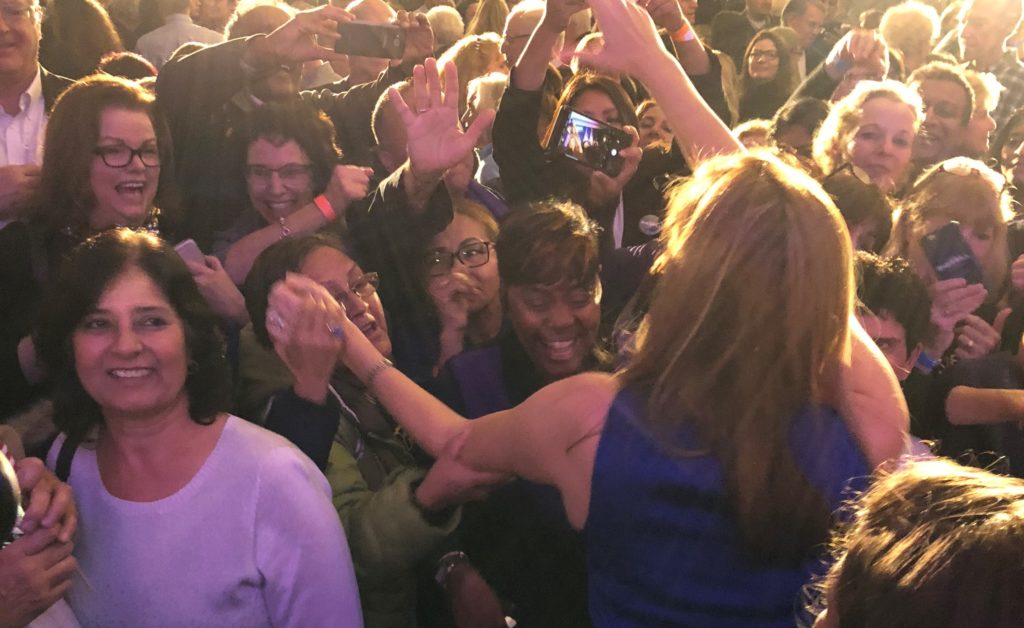The 2018 Elections and the Long Road to Gender Equity in Government

Over the past two years we saw a record number of women engage in the political arena—women ran for office, marched in the streets, and volunteered for political campaigns. Women’s participation in all its forms powered the Democratic takeover of the House of Representatives on Tuesday. This is a historic moment. Women have stepped up en masse and they have won.
Yet while women voted in greater numbers for Democratic candidates than they did in 2016, significant gender/racial gaps in voting patterns remain. Exit data from CNN found that 59% of women voted Democratic in the House races, compared to 47% of men; this represents a wider gender gap than 2016. And when we look across race, African American women remain consistently Democratic voters—with 92% supporting Democratic House candidates. Latina women also voted in significant percentages for Democrats (73%). In contrast, 49% of White women voted Democratic candidates into office while 49% voted Republican. Looking across categories of White women—59% with a college education voted democratic; whereas 56% without college degrees voted for Republican candidates. And, unlike 2016, high percentages of both married (54%) and unmarried (66%) women voted Democratic this year. While Democrats did peel some White women away from Republicans this year, the racial/gender gap remains significant.
As a result of the midterms, the 2019 Congress will be seating a record number of women. Come January there will be over 100 women serving in Congress—a number greater than at any other point. Here in New Jersey, Mikie Sherrill will join Bonnie Watson Coleman as the second woman in the Congressional delegation—flipping a previously Republican-held seat. But Congressional wins are not the only story – a considerable number of local and state office holders across the county will now be women. And they are a diverse group, spanning across the lines of age, race, ethnicity, sexuality, gender and religion, representing Americans both throughout the country and at all levels of government.
What can be drawn from all this? Yes, women candidates did smash barriers this year; however, there remains a long way still to go for full gender equity in government. Here in New Jersey while voters have doubled the state’s female Congressional representation this year (from one woman to two women); our delegation is still overwhelming male. In addition, at the state level women still make up a smaller percentage of representatives in the Senate and Assembly than do men. According to the Center for the American Women in Politics (CAWP) just 30% of our state representatives in Trenton are women. The various roles women played - as candidates, activists and voters – in sending a diverse group of new Congressional representatives to Washington this January should provide insight and guidance to our state parties to more fully address gender equity. Ensuring women have meaningful roles in shaping politics and policy is not only critical but necessary for there to be representation that reflects the diverse electorate. One cannot continue to count on women’s votes at the polls and not provide them full space at the political table.
Women are not, however, a monolithic category. White women did vote Democratic in greater numbers than 2016. But while they not only lagged behind women of color, it was their vote that helped push Ted Cruz and Ron DeSantis to their victories. And in the Georgia governor's race, of the votes counted thus far--73% of white women voted for Republican Brian Kemp. In contrast, 97% of Black women voted for Stacey Abrams. And closer to home, NBC exit polls found that while Senator Menendez may have more women’s votes overall (56%), he lost White women’s votes (46%). Just one year ago, Phil Murphy’s win also showed significant gender/racial gaps. While 94% of Black women and 88% of Latino women voted for the Governor, he only captured 44% of White women’s votes.
There are hard questions to consider about the gender/racial voting patterns here in the state and nationally. Are many white women voting their racial privilege at the expense of their gender? Are white women inclined to vote with and for the patriarchal white hierarchy to maintain and sustain the power and privilege that places them in position of greater status than women of color? Are their voting patterns consciously or subconsciously informed by attempts to maintain racial privilege? Women are not being asked to vote for a woman candidate simply because she is a woman; nor should women be voting as a bloc. But there needs to be reflection on women’s voting patterns and the implications.
The facts of how women voted -- specifically of how white women voted -- are now openly before us all, providing the opportunity to both ask and answer these deeper questions both nationally and in New Jersey. The discussions will be hard and often uncomfortable. Fortunately, this election provides us the opening to begin these raw and honest conversations.





